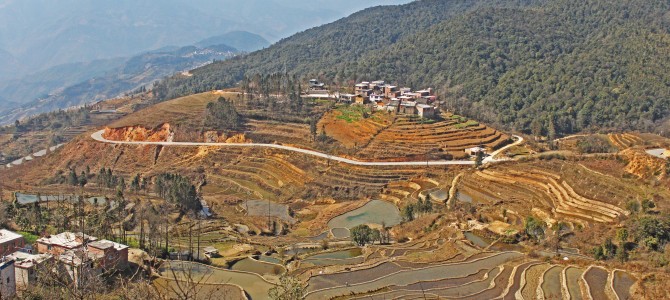
Chengyang Villages – Famous for their Wind and Rain Bridges. Like many Chinese towns with some cultural wealth, this group of towns charges an entry fee, though reportedly, the fee does not go to the people, but rather the government. The area remains in constant renovation as the Chinese tourism machine moves in.
Tourism in China is a weird thing. The Olympics of 2008 in Beijing spotlighted this once stigmatized powerhouse in a new light and the influx of tourists, curious to discover it’s rich history and culture, came pouring in from all directions. And the Chinese government sort of understands the process to deal with this. People want to be able to access the sites, the flavors and people that Maoist China tried to subjugate, repress and ultimately uniform (They use none of those terms, nor did the Maoist government do ANYTHING like that).
Their solution to this semi-new venture, tourism, is what’s strange. Like a flawed translation on many English signs throughout China, there seems to be a bit of a miscommunication of what international tourists are interested in seeing and how what their interested in seeing is expected to be presented. That’s a vast generalization, but for myself, if fly half way around the world to see something, I want to see something that is at least somewhat authentic and real. That’s the difference between seeing it in person and via media. Attached to this authenticity is an indescribable feeling of achievement, a connection to something beyond one’s own world, and the thrill of experiencing, immersing and discovering something new for yourself. Yet China’s approach to their unique cultures, languages and especially places, is reconstituting, rebuilding, modifying rather than preservation. Many of the historical sites that survived the Red Guard are being remodeled to provide a Disneyland-like, rather than an emerging experience in history. The grit, the real businesses, even the buildings themselves, have been replaced by five star accommodations, vendors selling chachkies and pre-fab, historical facades. One of China’s famous UNESCO heritage sites, Lijiang, almost lost it’s heritage status for attempting to rebuild the ancient black tiled roofed town as a resort, after one of it’s many earthquakes. It’s everywhere. Look in your China guidebooks. 9 times out of 10, the historical building you are standing in has been rebuilt. From Qianmen Business District in Beijing (torn down and rebuilt exactly the same) to large sections of the Great Wall.

Around 20km away from Yangshuo, unlike the other famous stone bridge, Dragon Bridge, this 600 year old marvel remains unscathed by tourism and the fleets of river boats. The question is for how long?
Though maybe this is a very North American stance on tourism. Maybe China is focused on local tourism, since for Chinese nationals, it’s very difficult to impossible to leave the country. On that subject, I simply have my observations of large buses, unloading their leader with their volumed up megaphones and umbrellas, followed by hoards all wearing the same hats, so they know who they should follow, blending into an earthen colored mass, filling up quaint, quiet and historical places with bursting commotion, noise and refuse. Pictures are snapped, mechanically, fingers are held in peace signs, or two hands come together to complete an unbelievable heart, occurring in no matter what venue, winding cobblestoned street or tranquil holy temple. I fear though that the “real” China that the international community strives to locate is fast becoming theme parks, parades or simply, like the hutongs of Beijing and Shanghai, being demolished for shinier, newer facilities, that cheaply emulate something that could have stood for a thousand more generations.







